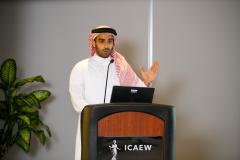GCC To See Marginal Economic Growth In 2019
The GCC is expected to post economic growth of 2.3% in 2019, a marginal improvement on the previous year of 0.3 percentage points. According to ICAEW’s latest Economic Insight report, the GCC economy will be weighed down by renewed OPEC-plus oil production cuts and lower oil prices, with the main source of growth coming from the non-oil sector.
Economic Insight: Middle East Q1 2019, produced by Oxford Economics, says despite a strong drive in recent years by GCC authorities to diversify their economies, oil continues to play a dominant role, constituting up to 46% of total GDP. As such, the renewal of the OPEC-plus oil production cuts will limit the oil sector’s contribution to overall growth in 2019.
The oil sector will also be dampened by lower oil prices, which is forecast at US$64pb in 2019, down by US$7pb from the average in 2018. The oil price trajectory suggests many GCC countries will struggle to balance their budgets in 2019, as the price needed to cover their expenses is well above the current price forecast, notably in Bahrain and Saudi Arabia, which need average oil prices of US$110pb and US$78pb respectively in 2019.
The non-oil sector in the GCC is expected to be the primary engine of growth in 2019, forecast to grow by 3.1%. This will be supported by higher government spending, notably in the UAE and Saudi Arabia, continued reforms and project spending like Qatar’s 2022 World Cup and the UAE’s Expo 2020, as well as stimulus plans geared to support the private sector.
Mohamed Bardastani, ICAEW Economic Advisor and Senior Economist for Middle East at Oxford Economics, said: “As lower oil prices and production cuts hit the GCC, the non-oil sector will be the main growth engine in 2019. Recent oil market volatility highlights the region’s need for continued economic diversification efforts, including fiscal and structural reforms. GCC governments will have to play an ever growing role in stimulating economic growth in 2019.”
UAE’s oil and non-oil sector to drive economic growth in 2019
Economic activity in the UAE is set to accelerate to 2.2% in 2019, up from an estimated 1.7% in 2018, buoyed by a pick-up in non-oil activity, rising public spending at the Federal and Emirate levels, higher investment ahead of the highly anticipated Expo 2020 and continued regional economic recovery. According to ICAEW, both the oil and non-oil sectors are expected to be supportive of growth this year.
Oil production in the UAE picked up in 2018 to mitigate for tightening global oil markets, notably after the US imposed sanctions on Iranian oil exports. Oil production is expected to rise further and average 3.07m b/d this year, up from an average of 3m b/d in 2018, reflecting continued investment by the UAE to expand production capacity. The oil sector is forecast to grow by around 2.5% in 2019, marking the fastest growth rate for the sector in three years. But higher production will be weighed down by lower oil prices in 2019.
In contrast, the UAE’s non-oil sector is expected to accelerate from an estimated 1.3% in 2018 to 2.1% in 2019. Growth in the non-oil sector will be supported by expansionary budgets and various pro-growth government initiatives, notably in Abu Dhabi and Dubai, which collectively account for an estimated 90% of the UAE’s GDP.
The Dubai government has also announced a number of initiatives to support growth, including lowering certain taxes and fees and measures to reduce the overall costs of doing business for key industries. Large-scale projects in preparation for Expo 2020 and new visa rules are expected to continue boosting tourist arrivals in UAE, helping Dubai to maintain its status as a major global tourist and FDI destination.
Michael Armstrong, FCA and ICAEW Regional Director for the Middle East, Africa and South Asia (MEASA) said: “The UAE has done a tremendous job in implementing much needed economic reforms in its aim to diversify the economy and achieve its Vision 2021 goals. Large-scale projects in preparation for Expo 2020, new visa rules, expansionary budgets and various pro-growth government initiatives are expected to contribute to the overall growth of the economy in 2019. The predicted growth of the non-oil sector underscores the UAE’s ambitious economic transformation agenda.”
Despite general improvements in the macroeconomic environment, the real estate market remained weak throughout 2018 as residential sales prices continued to fall. The real estate market slump has weighed heavily on Dubai’s stock market, which was down by nearly 24% year-on-year in February 2019, while Abu Dhabi’s stock market was more insulated, growing by 8% year-on-year in January 2019. Real estate market conditions are unlikely to see a notable rebound this year, reflecting strong anticipated supply growth and still sluggish job market conditions.
Job creation also slowed from 2.6% in the first three quarters of 2017 to 1.6% for the same period in 2018. More tellingly, key sectors shed some jobs: total employment in services, which accounts for almost 20% of total employment, was down by 1.3% year-on-year in Q3 2018, while ‘transport, storage and communication’ and ‘manufacturing’ sectors declined by 4% and 1.1% respectively over the same period.
Saudi non-oil economy to continue to drive growth in 2019
The economic outlook for Saudi Arabia is set to grow at a stable pace of around 2% in the coming year. In 2019, record budget spending and various pro-growth government initiatives will ensure faster expansion of non-oil activity, even as oil sector growth slows.
Saudi Arabia remains firmly on the transition path under the auspices of Vision 2030 – the country’s economic blueprint first unveiled in 2016. The plan has seen numerous reforms being implemented over the past year, including the launch of the 5% Value Added Tax and energy price reforms, and will continue to shape the Kingdom’s trade and investment strategy.
Preliminary estimates show that GDP grew by 2.2% in 2018, a sharp improvement on the 0.7% contraction in 2017. Activity was supported by both oil sector expansion and faster growth in the non-oil sector. Higher state spending, forecast to rise by 7%, and pro-growth initiatives, will support non-oil growth in 2019, amid continued diversification efforts.
The contribution from the oil sector to growth will again weaken in 2019. January estimates indicate Saudi authorities slashed production and on average crude output will rise only marginally this year from the 10.3m b/d recorded in 2018. Meanwhile, the Saudi oil export price will likely be lower, weighing on government oil revenue. With the oil sector accounting for some 44% of total GDP, Saudi authorities are investing heavily in hydrocarbon-related projects, which include large contracts such as the Jizan refinery and the Fadhili gas plant.
While Saudi Arabia’s non-oil sector has been resilient, momentum remains weak. The Emirates NBD Purchasing Managers’ Index for Saudi Arabia (a gauge of activity in the non-oil private sector) averaged 53.8 in 2018, the lowest annual result in the series and well below historical levels.
The index started 2019 on a stronger note. High levels of optimism and recovering credit growth suggest that non-oil activity should pick up this year. Growth in the non-oil sector is expected to accelerate to 2.6%, supported by expansionary fiscal policy and the private sector stimulus that was announced in late-2017 and extends up until 2021.
Michael Armstrong, FCA and ICAEW Regional Director for the Middle East, Africa and South Asia (MEASA), said: “Saudi Arabia continues to work towards Vision 2030 as its government remains focused on boosting the contribution of its non-oil economy. A record budget spending and various pro-growth government initiatives will most certainly help boost the country’s economic diversification agenda as oil sector growth slows.”
Hiring activity in Saudi Arabia remains subdued – over time this may complicate the Vision 2030 job growth goals. The latest employment survey (Q4 2018) highlights the challenge of reaching that goal – the jobless rate among Saudis stands at 12.7% currently and job creation for Saudi nationals has been relatively weak in 2018.
More broadly, progress on some key initiatives underpinning the ambitious economic transformation have stalled, including the much-anticipated sale of shares in Aramco. These delays cloud the prospect of attaining the Vision’s other goals, though the authorities will continue to support the private sector in taking a more meaningful role in terms of generating output and employment. This is clearly evident from the government’s budget for 2019, which balances support for economic growth with deficit reduction.
In 2018, the introduction of the 5% VAT and hikes in electricity tariffs and gasoline prices led to an improvement in non-oil revenues but raised living costs and put a burden on private sector activity. Households should get some reprieve this year. Inflation is expected to decelerate to 1% this year, down from 2.5% in 2018. The pace of monetary tightening will also slow, as we forecast no rate hike in the US this year, which will keep the cost of borrowing relatively unchanged in 2019.
The full Economic Insight: Middle East report can be found here: http://www.icaew.com/en/technical/economy/economic-insight/economic-insight-middle-east








